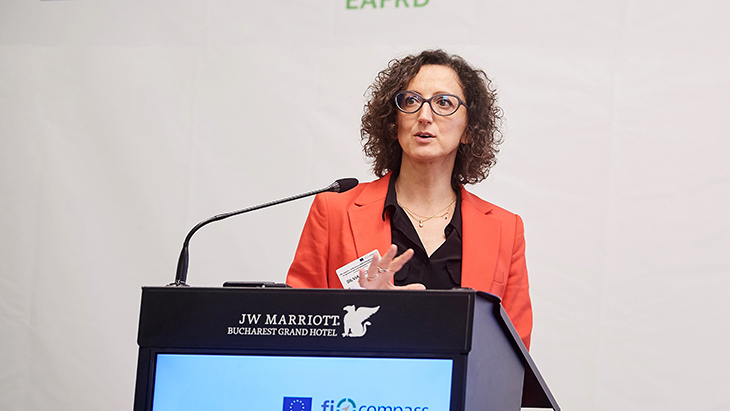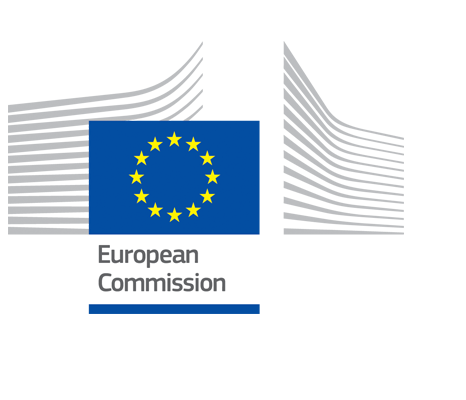The use of financial instruments in Member States CAP Strategic Plans

Main topics: Preparations for the future CAP and role of EAFRD financial instruments in the Member States CAP Strategic Plans for achieving Green Deal objectives, generational renewal and the long-term vision for rural areas.
A discussion with Silvia Michelini, Director at European Commission’s DG AGRI (Directorate-General for Agriculture and Rural development), hosted by Mario Guido from the fi-compass team at EIB.
Good morning everyone! Welcome to a new episode of the fi-compass Jam Sessions podcast. I am Mario Guido and I will be your host, today.
Today, we welcome Silvia Michelini, Director at the European Commission’s Directorate-General for Agriculture and Rural Development.
With Silvia, we will talk about the adoption by Member States of the Common Agricultural Policy Strategic Plans (CAP). We will also discuss the role that financial instruments under the European Agricultural Fund for Rural Development, the EAFRD, can play in the future. Welcome, Silvia, and thank you for joining us.
Good morning, Mario! And good morning to our listeners and thanks to fi-compass for organising this second podcast on EAFRD financial instruments.
So, Silvia, the trialogues between the European co-legislators on the new legislative framework for the new CAP are at a final stage, and the discussions are expected to be finalised before the summer.
Could you, please, tell us more about the state of play in the preparation of the CAP Strategic Plans?
Indeed, Mario we are at a key point for the CAP reform process, and we hope to close the agreement very soon. In the meantime, we are working very intensively with the Member States for the preparation of their CAP Strategic Plans. These CAP Strategic Plans are very important for us: they are strategic documents where the Member States are going to present the assessment of their needs, their strategies, as well as the mix of interventions they want to use to reach their objectives, which are, of course, the ones of the Common Agricultural Policy.
These Strategic Plans are not only planning tools,they are also also strategic tools, where we want to see the ambition of Member States in reaching the CAP objectives. We also want to see a particular focus on environment and climate, in line with the European Green Deal.
Now, if you ask me about the state of play of this preparation in the different Member States, I would tell you that it is different depending on the different Member States, but what is sure is that we are working with all of them in the framework of a dialogue, which we call ‘structured dialogue’. This is because we want to work intensively, early on, in this informal phase. The timing is very stretched, because we need to work informally this year, and, at the end of the year, we expect each Member State to submit to the Commission their draft plans. Next year we are going to work on the assessment of the plan and we want to adopt them by the end of next year, so from 1 January 2023, the new CAP will be there, in force.
Thank you, Silvia. It’s nice to see that Member States are already working on the new programming period. From your side, in DG AGRI, how do you help Member States to prepare for the new CAP Strategic Plans? And in particular, how important are the recommendations that DG AGRI is providing to the Member States?
We are doing quite a lot to support the Member States in this process. Indeed, we have started this structured dialogue, as I was mentioning before, so we are in real close contacts with the representatives of the Member States.
We have organised many workshops and expert groups to support them in the preparation of the CAP Plans, and we will continue to do so throughout the next period.
You rightly recall the recommendations to the Member States: last December the Commission adopted recommendations to each Member State in relation to the CAP objectives. We analysed the situation in each Member State and we came up with suggestions on how to cope with the different elements of the CAP objectives, in order to help Member States identify their needs and the mix of interventions, but also to help us, in a way, in the assessment of the CAP plans when they will be submitted.
Regarding the new programming period, a lot was said about the new delivery model. Can you tell us more about this new approach?
The key word for this new delivery model of the Common Agricultural Policy is ‘performance’. Indeed, we focus on performance orientation of the future plans. We want them to be based on a sound intervention logic. We also want to ensure that the Member States fix their objectives, as well as the way they will reach them.
This might not sound so new for rural development, because in a way we are used to strategic programming there, but it is a novelty with regards to the overall CAP, as most of the Common Agricultural Policy tools would be under the CAP plan.
Another element I would like to mention, is the flexibility which is left to the Member States – more flexibility than in the past to design the mix of intervention needed to reach the objectives of the CAP. Also, I would say that a lot of synergies are gained in this process, between what we call the first pillar of the CAP – mostly direct payments, but also markets – and what we call the second pillar - rural development. For example, we are looking at more synergies in the area of what we call the ‘green architecture’, so, the focus on climate and the environment, but also, for example, on generational renewal.
You mentioned a very important point: generational renewal. We talked about this a lot in our recent fi-compass webinars. What role will young farmers play in the future, especially in the context of the long-term vision for rural areas? And would you agree that Member States shall set up financial instruments specifically for young farmers?
Indeed, Mario, this is a very important point. We want to increase the number of young people entering farming. We are not happy with the current numbers. If we look at them, farmers below the age of 35 years old are just 5% of all managers, while those aged above 55 years old are about 58%, and we want to change that. Therefore, we want to help Member States devote more efforts to this important objective, because more young people entering farming, also means more young people in rural areas, which means more lively rural areas. We have asked the Member States to devote a share of amounts of funds under direct payment to interventions that are focusing on young farmers. They can decide whether to use the first pillar tools, top-up payments or installation grants under the second pillar, or both of them, in the perfect mix they find opportune, based on their specific situation.
Indeed, I see a strong role for financial instruments. One of the main difficulties for young farmers is the access to finance, and, therefore, I see an important role for financial instruments, responding to the concrete needs identified by the Member States following the analysis that they will do. Here, I would like to refer to an important study, which was prepared last year, on the needs of financing in the agriculture and agri-food sectors. There, we see that there is an important gap and that we can help with financial instruments. Already now, young famers are a target group in our financial instruments, in the sense that they are often given better conditions, for example lower interest rates.
Indeed, young farmers and generational renewal are key issues in the framework of an important political initiative, which will be adopted very soon, in the next few days. It is the Commission communication on the long-term vision for rural areas. It is an initiative for which our Commissioner, Wojchiechowski, in charge of agriculture, is in the lead, working together with Commissioner Ferreira, who is in charge of cohesion, as well as under the coordination of the Vice President Šuica, who is responsible for demography and democracy. Indeed, this Commission Communication will set out the vision of what we want rural areas to become in the perspective of 2040, and all the different steps to get there. And indeed, generational renewal is also going to be important, as we know that it is one of the challenges of rural areas.
This is not something that we are developing in Brussels, we have actually opened up a wide consultation of stakeholders and citizens, we have organised a lot of events. So, this is a real participative process, in which we have involved citizens as part of this process, which is a real bottom-up one.
Very interesting. We look forward to this new communication then. Support for young farmers is very important and it’s nice to see the commitment of DG AGRI in helping fresh energies entering in the sector.
The EU Green Deal and the promotion of a green transition are key priorities for the Union, including under the CAP. Digital transition is also another very relevant objective. How do you think the EU rural development policy will contribute to these goals? And, will financial instruments, supported under the CAP, play a role to help achieve these policy objectives?
Mario, you refer to the Green Deal, which is indeed the important growth strategy of the EU, and agriculture, as well as the Common Agricultural Policy will do its part. Last year, we published two strategies, the biodiversity strategy and the ‘Farm to Fork’ strategy, which look at how to make the agriculture and agri-food sectors greener, as well as how to make food systems fairer, healthier and more environmentally friendly. We set up a number of targets linked to this green transition, but we also looked at the aspect of the digital transition, because we want the green and digital transitions to go together, hand in hand.
To give you an example, for the green side, we propose a target of reaching 25% of areas covered by organic farming by the year 2030, and for the digital transition, we have an important aim: for all rural areas to have access to fast broadband by 2025.
Once in place, the future CAP will further boost the green and digital transition, and we have several instruments for that. We have area-based payments looking at practices by farmers, but we also have investments and other tools, which can be used for that.
In this context, I really believe that financial instruments are there to help. They really enable the potential of agriculture to respond to these ambitious targets. For example, they can finance technological investments, research, innovation; they can help look at riskier types of projects involving digital solutions, energy saving machinery and equipment, etc.
We have seen a lot of take-up of financial instruments in this area, and we hope to see even more with the programming of financial instruments in the future CAP Strategic Plans. And for sure we need that. Last year we prepared a study looking at the financing gap in the agricultural and agri-food sectors, and we looked at a figure, which is between EUR 20 to 47 billion for agriculture in the EU, and this was before the pandemic. You can imagine that the pandemic crisis has not really helped to fill the gap. Therefore, indeed we need more financial instruments in the future.
For sure there is a lot of work to do under the new CAP, but, at the same time, it’s nice to see that there are some interesting novelties that can help open up new opportunities.
Now, looking to the current programming period, we know that there is a transitional period, for the EAFRD programmes, with rules that are already approved and that are in place.
I would like to ask you, what impact do these rules have on already existing financial instruments?
Indeed, we set up transitional rules to cover this year, and next year (2021 and 2022), so that support to farmers can continue, waiting for the CAP plans to kick in, in 2023. We also have new funds to support this transition, funds which come from the multi-annual financial framework – the MFF, and from Next Generation EU, with a direct injection into the rural development funding.
Therefore, with these transitional rules, financial instruments can continue to operate during this year and next year and this is very important, because I believe that continuing to work on this will lay the foundation for the future place of financial instruments in the CAP post 2020. Financial instruments are there and we see a lot of things happening even in this period. For example, in Greece there was an operation which started in March, this year. We also have countries like Bulgaria, Lithuania, and Latvia where financial instruments will become operational later this year. So, I see this transitional period as a very positive period, with a positive impact also for the future.
At the moment, we have 31 financial instruments operating and EUR 760 million of public resources programmed for financial instruments. More than 5 100 guarantees and loans are given out supporting EUR 645 million of underlining loans, a number that has more than tripled since 2019.
We have also seen an increased demand by farmers for both investments and working capital since mid-2020. Some of these investments have already a very high leverage level – for example, in the case of one financial instruments in Italy - Friuli Venezia Giulia, we have already reached a leverage of 20x. In another case, in France, we are close to 10x. Our expectation, which is an important leverage, is to manage to reach EUR 2 billion of underlining loans by the end of this period, which will be a great success for the policy and a very good foundation for the future.
This experience for me is vital and we believe that, with all this positive feedback and momentum, Member States can continue to use financial Instruments in the future, as farmers’ demands are permanently growing.
Thank you very much, Silvia, for these very interesting insights and for sharing your expectations for the future. It was a real pleasure to talk to you today.
Thank you, Mario for this opportunity, and I am looking forward to the new fi-compass programme and to what we can do to facilitate the use of financial instruments under the CAP.





